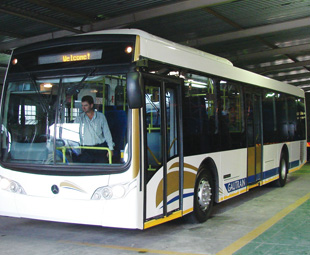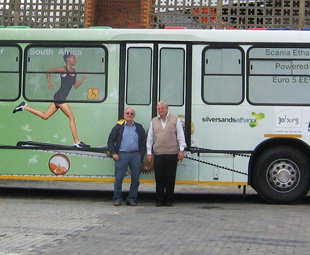A bus for all occasions

From taxis to the Gautrain, public transport in South Africa is on the move. It’s not our infamous minibus taxi industry that has benefitted most, however; neither is it our first high-speed train that’s changing the face of local public transport. Instead, it is the humble bus…
Despite the widespread growth of an unregulated minibus taxi industry both during and post-apartheid, bus operators have continued to grow as well – despite often violent turf wars between the two modes of transport, particularly during the 1990s.
Today, Government subsidises a number of municipal and private bus operators, while major cities around South Africa are implementing Bus Rapid Transit (BRT) systems in their commercial centres. This is not to say that minibus taxis do not also have an extremely important role to play in public transport, however.
The Taxi Recapitalisation Programme (TRP) – spearheaded by the South African National Taxi Council (Santaco) in conjunction with some of the country’s bigger finance houses – was a governmental effort to regulate one of the most notoriously unregulated industries in South Africa, as well as significantly improve the safety of the hundreds of thousands of people who rely on mini-bus taxis to get them to and from work each day. At the time of the project’s implementation, it was estimated that the industry carried almost 68% of commuters on a daily basis. The TRP was introduced in 1999 with a view to replacing aging and dangerous taxis with safer, reliable, efficient and comfortable vehicles.
With this in mind, local manufacturers designed and produced models for the industry based on specific safety and seating conditions. In terms of the TRP, registered taxi operators receive R50 000 for each aged or unroadworthy taxi brought in to be scrapped; the equivalent of a 20% deposit towards a new vehicle.
 Yet, despite many new minibus taxis on our roads proudly displaying South Africa’s national colours, the TRP has fallen far short of its objectives. In March 2008 Santaco “temporarily” withdrew from the TRP asserting that it was becoming difficult, if not impossible, for taxi operators to render an affordable service to customers while operational costs exceeded their monthly income.
Yet, despite many new minibus taxis on our roads proudly displaying South Africa’s national colours, the TRP has fallen far short of its objectives. In March 2008 Santaco “temporarily” withdrew from the TRP asserting that it was becoming difficult, if not impossible, for taxi operators to render an affordable service to customers while operational costs exceeded their monthly income.
The scrapping allowance of R50 000 was considered inadequate given the cost of new replacement vehicles. While, in Santaco’s view, the TRP has undoubtedly benefitted manufacturers by boosting new vehicle sales, many minibus taxi operators participating in the programme soon face insolvency.
“As much as Santaco embraced the TRP and continues to do so with confidence, the initiative has reached a dead end for the ordinary taxi operator due to various processes entailed in this change to the public transport system,” commented A.J. Mthembu, president of Santaco, on the association’s decision at the time.
To this day, the taxi industry remains unregulated. Turf wars over contested routes continue to plague our roads and public transport is still too expensive for average South Africans, many of whom spend up to 40% of their monthly salary on transport when the international norm is 5%.
Enter BRT
Nevertheless, Government has remained committed to finding a solution to South Africa’s public transport woes, focusing predominantly on the commuter bus sector.
BRT is a world-wide phenomenon that has fared particularly well in cities needing to implement a public transport system well after the city has grown and developed. Unlike Europe, the United Kingdom (UK) and the United States (US) – whose public transport systems grew organically with most major cities – many developing nations have only implemented public transport systems after the fact. In South America, whose cities bare a striking resemblance to South Africa’s, BRT has been remarkably successful.
BRT first entered the world stage in the 1970s with the great urban success story of Brazilian city, Curitiba. The concept of a public transport system that could be developed using existing infrastructure, while offering a feasible alternative to rail transport, soon evolved and spread across the globe. Today, there are BRT systems across the US, Canada, Latin America, Asia, Australia, Europe and now Africa.
In October 2001, the international Institute for Transportation and Development Policy (ITDP) launched a new initiative to support the development of BRT systems worldwide. BRT offers transport authorities the opportunity to provide high quality, state-of-the-art mass transit at a fraction of the cost of other options. It is the system’s relatively low cost that makes it possible for cities across the spectrum of financial and developmental circumstances to implement an effective and sophisticated mass transit system based on the BRT model. Over the past several years, ITDP has been involved in the decisions made by numerous municipalities to opt for BRT.
It is also a highly reliable, regulated system – a major drawcard to South African commuters, who have become resigned to the relatively expensive and unreliable minibus taxi as their only transport option.
According to councillor Amos Masondo, Johannesburg’s executive mayor, the citizens of Johannesburg undertake a total of 3.5 million trips every day. Speaking at a public transport summit held in August 2009, Masondo revealed that nearly half (47%) of these trips are by public transport, of which 773 000 (72%) are made by minibus taxi, 230 300 (14%) by train and 148 050 (9%) by bus.
The City of Johannesburg’s BRT system, Rea Vaya, went on-line for the first time in August 2009. While sporadic outbursts of taxi violence in protest against BRT continue to plague the system, the city has remained steadfast in its determination to provide commuters with a safe, affordable public transport alternative.
The first tender awarded for Rea Vaya buses went to Scania, tasked with supplying143 buses for the first phase of the BRT system – including 41 articulated buses and 102 conventional rigid models.
“For Scania, this is an important breakthrough in South Africa’s rapidly growing city bus market,” said Christoffer Ljungner, managing director of Scania Southern Africa, when the winning tender was announced. In Johannesburg alone, about 1 000 new buses will go into service over the next four years, and other major South African cities implementing BRT systems of their own are likely to follow this trend.
 Before awarding the tender however, the city authorities consulted with the Clinton Climate Initiative (CCI) and concluded that BRT engines should meet Euro 4 environmental standards for CO2 emissions. This is one level higher than the current South African national standard and requires a 60% reduction in particulate emissions, as well as a 30% reduction in nitrogen oxide (NOx) emissions compared to Euro 3.
Before awarding the tender however, the city authorities consulted with the Clinton Climate Initiative (CCI) and concluded that BRT engines should meet Euro 4 environmental standards for CO2 emissions. This is one level higher than the current South African national standard and requires a 60% reduction in particulate emissions, as well as a 30% reduction in nitrogen oxide (NOx) emissions compared to Euro 3.
Accordingly, the Scania articulated buses – which are 18 m long and have room for 112 passengers – are equipped with Scania 9 l, 310 hp Euro 4 engines. The standard buses are 12 m in length, can carry up to 81 passengers, and are equipped with Scania 9 l, 270 hp Euro 4 engines. All engines feature exhaust gas recirculation (EGR) technology, which reduces emissions during combustion, eliminating the need for after-treatment equipment. Scania is also involved in the Rea Vaya driver training programme.
However, while BRT is an important role player in Johannesburg’s and other cities’ inner city public transport upgrade, it is far from the be-all and end-all. Rather, an integrated system is needed that will include buses of all shapes and sizes – one of which is the minibus taxi.
Integrated rapid transport
“The future of public transport in this country lies in an integrated system that utilises a variety of different vehicles,” explains Ray Karshagen, management board member for business development at MAN Truck and Bus.
“For example, mass-carriers – such as articulated buses, or bus trains – should be used during peak periods, while midi-buses can be used in between peak periods,” he elaborates. MAN’s 22 m bus train is a high-floor, front engine bus that seats 114 passengers. As such, it is a cost-effective investment for commuter bus operators, offering more passengers per bus and driver. However, while it is the ideal bus for peak periods, and therefore growing in popularity amongst local operators, it has a specific role to fulfil. The same is true of smaller, traditional buses.
Feeder routes for main bus routes, BRT and even the Gautrain can be serviced with a range of different buses, from low-floored curb-side buses, to midi-buses and minibus taxis. In an integrated system, there is room for everyone.
“The key to public transport in this country should by IRT – integrated rapid transport – which utilises all the various modes, models and operators we have to offer,” says Karshagen. “Pursuing the ideal of IRT would create a fully comprehensive system that could cater for the masses and all this country’s various operating conditions.”
Both BRT and the Gautrain are examples of this ideal, albeit on a smaller scale. Rea Vaya utilises low-entry articulated buses for its trunk routes and standard buses for feeder routes, while Mercedes-Benz was awarded the tender to supply 125 buses for Gautrain’s dedicated bus feeder fleet.
According to Jan Aichinger, divisional manager, Mercedes-Benz Bus Division, the Mercedes-Benz 0500U 1726 low-entry buses selected to service the Gautrain are ideally suited for the project. “These buses have a 35 to 45 seat configuration with standing capacity for approximately 17 passengers,” he said. “The low-entry design makes accessibility easy for wheel-chair users, young children and the elderly.” The complete order will be delivered during the course of 2010.
The Gautrain bus fleet will operate on approximately 36 routes from nine of the ten Gautrain stations (the exception being OR Tambo International Airport). Initially, the fleet will comprise the 125 buses already ordered, which together will cover nearly 430 km of bus routes and travel nearly 26 000 km every day.
On a greener note
Commuter buses also have another important function: they are much “greener” for the environment than private transport. Why? Simply put, for each bus train carrying 114 passengers, that’s at least 28 cars off the road; assuming people are car-pooling to work and their cars are full, which most are not.
“Public transport is already more environmentally friendly than normal transport, but there are technologies available that make buses even greener than ever before,” explains Dave Gregory, general manager, technical Metrobus.
In conjunction with two manufacturers, Scania and MAN-owned VW Trucks and Buses, Metrobus is piloting a green bus initiative. The two buses in question – a Scania ethanol bus and a compressed natural gas (CNG)/diesel dual-purpose Volksbus – will remain the property of their manufacturers, while Metrobus has undertaken to foot the bill for the buses’ running costs during the next six months.
“We bought the bus in order to be able to pilot this project in South Africa,” explains Winston Muir, bus sales exco, Scania SA. Of course, the bus has a Scania chassis fitted with a Marcopolo body. Scania South Africa, with some financial support from Scania Sweden, purchased the bus itself and will continue to run similar projects around the country once the Metrobus pilot project is complete. There are currently 450 Scania ethanol buses operating in the Swedish capital of Stockholm, so the manufacturer is no stranger to this technology.
The Volksbus is a 17.210 OD (DG Flex) bus which, according to Livingstone Mulaudzi, bus product manager at MAN Truck and Bus, is the first of its kind in South Africa. Operating on 90% CNG and 10% diesel, it is possible to switch the system over to 100% diesel if necessary.
The two buses will operate from the Metrobus Ferndale depot in Randburg, where they will refuel from a portable natural gas line supplied by Virtual Gas Networks and a portable ethanol tank supplied by Scania. The ethanol – based on the hardy sugarbeet – will be supplied by a local producer based in the Lichtenburg farming district’s Silversands community partnership programme.
This partnership not only supplies high-quality fuel (which must meet Scania’s standard of 92.7% strength) but provides an ideal opportunity for local, struggling farmers to derive additional value from their crops in the face of dwindling grain market prices. “The value of these projects is so far reaching,” says Gregory. “For every litre of ethanol we use, that’s one litre of foreign oil we don’t need to import. It also creates sustainable employment for local farmers and a whole new local industry from which our rural areas can benefit, over and above the environmental advantages of operating green buses.”
Published by
Focus on Transport
focusmagsa



